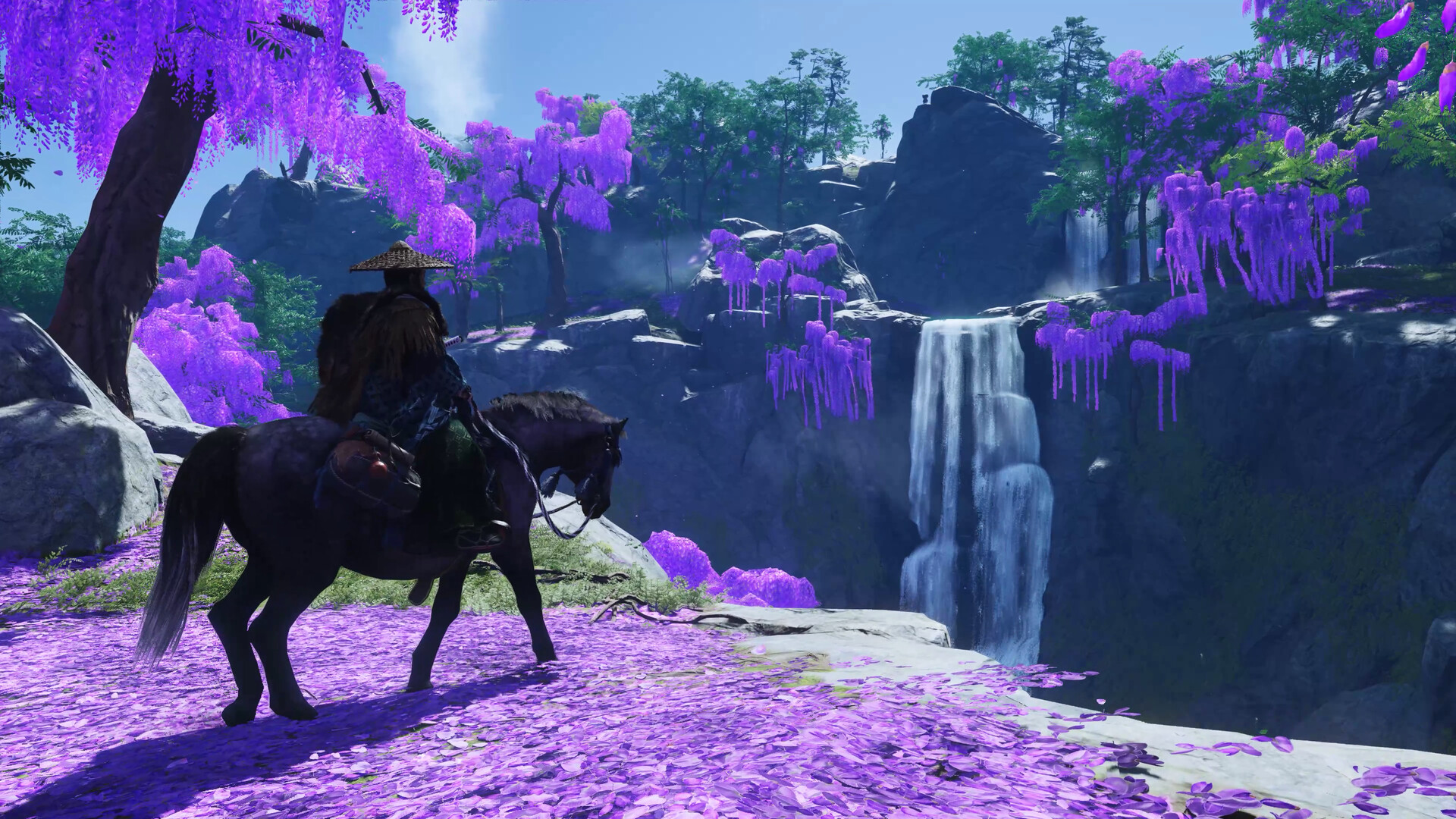Ghost of Tsushima Retrospective: A Meditation on Moral Compromise in Wartime

Disclaimer: this feature has spoilers for the 2020 game Ghost of Tsushima. You have been warned.

Nearly five years after its release, Ghost of Tsushima stands as a noteworthy contribution to gaming’s exploration of moral ambiguity in conflict. While its stunning visual presentation and fluid combat mechanics succeeded in capturing players’ attention, its thoughtful engagement with insurgency ethics places it among several significant games that have meaningfully addressed the casualties of adhering to tradition when confronted with overwhelming force.
From a warfare theory perspective, Jin Sakai’s evolution from traditional warrior to guerrilla fighter exemplifies the moral navigation required when conventional power structures fail against superior military might.
Sucker Punch Productions places players in the role of Jin Sakai, a samurai whose worldview shatters when the Mongol Empire, led by the fictional Khotun Khan, invades Tsushima Island. What begins as a familiar tale of heroic rebellion evolves into a complex meditation on the cost of abandoning traditional codes to achieve victory. While the gaming industry frequently reduces moral choices to simplistic binaries, Ghost of Tsushima crafts an experience that refuses facile answers, challenging players to consider what principles they might sacrifice when faced with an existential threat.
Idealogical Battleground

The central tension driving Ghost of Tsushima extends beyond the overt conflict between Jin and the invading Mongols. The true ideological battleground exists between Jin and his uncle, Lord Shimura. As the jito (lord) of Tsushima, Shimura embodies unwavering adherence to the samurai code, even as that code proves catastrophically ineffective against an adversary operating under entirely different axioms of warfare. Jin’s transformation from honourable samurai to the “Ghost,” an insurgent willing to poison enemies and strike from the shadows, constitutes the emotional and philosophical nucleus of the storyline.
This evolution defies simplistic moral categorisation, presenting instead what could be considered as a “guardian paradox”; the contradiction that emerges when those who define themselves by a code of honour must abandon that very code to effectively defend what they’ve sworn to protect in the face of supreme emergency. The game meticulously examines how Jin’s methodological shift represents not merely tactical adaptation but epistemological radicalisation in response to existential threat, a pattern observed across historical insurgencies, from the Haitian Revolution and Boudicca’s Iceni Rebellion to the Algerian War of Independence and various contemporary asymmetric clashes.
Lord Shimura’s condemnation of Jin’s methods, while never explicitly invoking the term “terrorist,” carries precisely this implication. By defying the shogun’s directives and abandoning samurai honour codes, Jin becomes branded a traitor whose tactics fall outside the parameters of legitimate warfare. This framing introduces a sophisticated discourse on the contested nature of legitimate resistance. The portrayal elegantly demonstrates how the demarcation between “honourable warrior” and “dishonourable assassin,” reminiscent of political philosopher Hannah Arendt’s observations on the relationship between power, violence, and legitimacy, often has less to do with the tactics themselves and more to do with who possesses the authority to render such judgments.
Gameplay as Political Theory

What elevates Ghost of Tsushima beyond a typical action-adventure is how its gameplay systems function as embodied political theory. The “Legend” meter operates as a sophisticated representation of what political theorists term “popular legitimacy,” a concept central to asymmetric conflict studies. While superficially tracking Jin’s growing reputation, this mechanic actually quantifies something considerably more nuanced: the social contract developing between Jin and the populace under occupation.
As contemporary scholarship on insurgency movements suggests, successful resistance against overwhelming military force is predicated less on martial prowess and more on establishing alternative governance structures that secure civilian loyalty. When players complete side quests and mythic tales, they are not merely accumulating power upgrades; they are witnessing the materialisation of political philosopher Max Weber’s concept of “charismatic authority”: leadership legitimacy derived not from tradition or legal structures but from extraordinary individual characteristics recognised by a community in crisis.
The combat itself narrates this story through its mechanics. Players can transition between honourable, face-to-face samurai combat and the stealthier, more pragmatic “Ghost” techniques. The game doesn’t constrain players to choose one path exclusively but instead encourages a blend of approaches depending on the circumstances, mirroring Jin’s own reluctant compromise between tradition and necessity. This dynamic reflects Clausewitz’s “paradoxical trinity” reconfigured for insurgency warfare. Operating outside established samurai hierarchies, Ghost of Tsushima reimagines the military-people-government relationship through gameplay mechanics: Jin’s evolving combat abilities represent the military dimension; the “Legend” meter quantifies his relationship with the people; and his conflict with Lord Shimura embodies the friction with orthodox governance.
Companions & Moral Complexity
The companion tales in Ghost of Tsushima serve as microcosms of the game’s thematic exploration of moral compromise. Each character’s journey parallels aspects of Jin’s development while adding layers to the game’s ethical dimension. Lady Masako’s vengeful quest shows how occupation strips away civilised pretence, transforming a noble matriarch into an avenging spirit. Jin’s uneasy alliance with her creates moments of profound ethical ambiguity as he balances respecting her rage with restraining her more brutal impulses.
While Masako’s tale explores vengeance born from personal loss, other companions reveal different facets of moral adaptation under occupation. Sensei Ishikawa’s pursuit of Tomoe, his former student who betrayed him by teaching sacred kyudo techniques to Mongols, juxtaposes his rigid orthodoxy against her pragmatic survival instinct. Yuna’s resourceful approach to survival catalyses Jin’s transition, while her brother’s execution by Khan despite her sacrifices highlights the brutal calculus of occupation. Her subsequent dedication to Jin’s cause represents not just a desire for vengeance but a reclamation of agency in a world where established power structures have failed to protect the vulnerable. Norio’s spiritual journey interrogates how hostilities corrupt sacred institutions, with his mercy killing of his tortured brother simultaneously violating his monastic vows while embodying Buddhist compassion.
These characters must each sacrifice fundamental aspects of their identity to navigate a world where time-honoured moral frameworks have lost coherence. Their stories show that Jin’s compromises aren’t aberrations but inevitable responses to societal collapse.
An Island Worth Preserving
Tsushima Island itself emerges as a distinct character, with dynamic weather systems and environments ranging from tranquil flower fields to blood-saturated beaches. The art direction employs colour and composition masterfully, with the innovative guiding wind mechanic serving both functional gameplay and aesthetic purposes. Rather than cluttering the screen with conventional waypoints, the game utilises natural elements to direct players, creating a more immersive experience that respects both the setting and player intelligence.
In Act 2, the Siege of Yarikawa stands as a particularly powerful demonstration of the game’s thematic depth. This pivotal sequence begins with Jin having to earn the grudging trust of a population that has suffered under his family name; Lord Shimura had violently suppressed the Yarikawa rebellion years earlier, leaving indelible scars within the community. Only by rescuing their captured fighters and proving himself fundamentally different from his uncle does Jin convince the village to join his rebellion.
The resulting confrontation against Khan’s formidable general Temuge culminates in a spine-chilling encounter that permanently alters Jin’s trajectory. What makes this sequence truly brilliant is how it demonstrates Jin’s legend growing not merely through combat prowess, but through Yuna’s deliberate mystification of his abilities. She transforms him into something transcending humanity, a ghost that cannot be killed—establishing a psychological dominance over the Mongol forces as effective as any sword. This moment perfectly encapsulates the game’s central thesis: warfare is waged not just through physical violence but also through narratives that construct perception and morale.
Beyond Entertainment: A Different Kind of Radicalisation
The discourse surrounding video games frequently invokes the tired trope that interactive media radicalises players toward extremism and terrorism, a simplistic narrative that misunderstands both games and radicalisation itself. Ghost of Tsushima navigates this question by demonstrating that games can indeed shape our thinking, but in substantive ways that expand our moral understanding rather than narrow it.
Through Jin’s journey, players confront difficult questions about resistance and legitimacy. By placing us in Jin’s position, the game challenges us to reconsider what we might do when established codes of honour fail in the face of overwhelming force: what options remain? Where is the line between liberator and terrorist, and who holds the power to make this distinction? The game doesn’t provide easy answers; instead, it creates space for players to wrestle with these questions themselves.
The narrative powerfully illustrates what political scientist David Kilcullen terms the “accidental guerrilla” phenomenon, where external invasion catalyses indigenous opposition that transcends conventional military doctrine. Jin embodies this concept perfectly, becoming an insurgent not by choice but by necessity, adopting tactics he would have once denounced.
Iki Island: The Perfect Counterpoint
The Iki Island expansion complements and complicates the main narrative brilliantly. Where Tsushima positioned Jin as the heroic underdog fighting against foreign invaders, Iki Island forces him to confront a painful reversal: here, the Sakai name is reviled, not revered.
Jin discovers that his father, Lord Kazumasa Sakai, was remembered on Iki not as a noble samurai but as a brutal oppressor who led a violent pacification campaign against the island’s natives. This revelation shatters Jin’s idealised memories and forces him to confront uncomfortable parallels between the Mongol occupation of Tsushima and the samurai subjugation of Iki. Most compelling is Jin’s reluctant alliance with Tenzo, the very man responsible for his father’s death. This uneasy partnership embodies the expansion’s central theme: the necessity of moving beyond cycles of vengeance to confront larger threats.
By the conclusion, Jin must reconcile with his father’s cruelty, a powerful character development that adds remarkable depth to his journey in the main game. Iki Island provides a crucial perspective shift that enriches the player’s understanding of Jin’s evolving worldview and reinforces the game’s contemplative exploration of how quickly the roles of oppressor and rebel can be reversed depending on historical context.
The Final Assessment
With the passage of time, Ghost of Tsushima’s cultural significance has only deepened as conventional warfare and asymmetric insurgency continue to shape our world. What makes the game particularly resonant is how it portrays the consequences of tactical necessity. Regardless of the choices players make in the final confrontation, Jin is ultimately doomed to become the wandering Ghost, condemned to banishment by the ruling class even as he earns respect from fellow warriors and devotion from the common people he protects. This represents an example of legitimacy paradox in the use of violence in armed conflict.
While Jin’s metamorphosis can be persuasively justified through principles of proportionality and necessary response to existential threat, the game’s strength lies in simplistically refusing to resolve this struggle. It acknowledges both the tactical validity of Jin’s choices and their cost to institutional legitimacy—sacrificing favour with the shogunate to secure the survival of Tsushima’s people.
Ghost of Tsushima’s artistic achievements certainly contribute to its lasting impact. Ilan Eshkeri’s evocative soundtrack and the game’s stunning visual design celebrate feudal Japanese aesthetics with remarkable dedication to authenticity. The score ranges from soothing Japanese flute melodies to bombastic Taiko drums and stirring string arrangements, creating an aural landscape as rich and dynamic as the visual one. Particularly noteworthy is the theme song, “The Way of the Ghost,” featuring Clare Uchima’s soulful vocals, which serves as a perfect emotional bookend to Jin’s personal odyssey.
But what truly stands out is how the game unflinchingly presents complex ethical questions through emotional storytelling without being reductive. The game remains relevant precisely because it captures an eternal dilemma: when honour becomes suicide and survival demands dishonour, what price are we willing to pay for either? In Jin’s impossible choice, we find reflections of conflicts that continue to define our world.





Leave a Comment